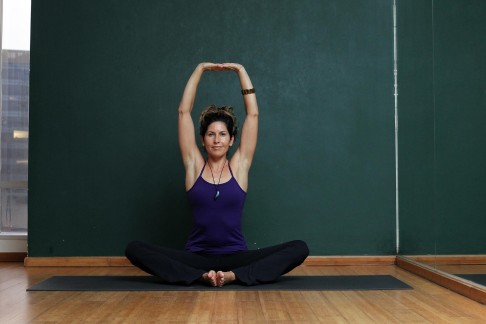
Yoga techniques to help new mothers recover from pregnancy
Although fit and healthy, yoga instructor Wendy Wyvill still felt the effects of pregnancy and childcare

As a yoga instructor for more than 20 years, Wendy Wyvill had a balanced posture and a strong, supple body free from aches and pains.
Then, 21 months ago, she celebrated the birth of her son. She soon started feeling a strain in her right wrist and back, and developed rounded shoulders, and hints of sciatica - numbness that starts in the lower back and travels down the legs.
Wyvill was suffering from what's known as "new mum's syndrome": injuries and bad posture arising from caring for a baby. Various movements such as carrying, feeding and lifting your baby can cause serious distress to the body if not performed correctly, even for someone as fit as Wyvill.
Age and a past life as a pro snowboarder played their parts in the pain, admits the 43-year-old Canadian. But motherhood was the main cause.
Breastfeeding was a challenge, because her baby had acid reflux. "So once the baby latched on, I didn't want to move," says Wyvill, who's been teaching at Pure Yoga for 8½ years. "I'd end up in crazy positions just to feed him."
Being right-handed, she also favoured feeding the baby from the left breast, cradling her son with her right wrist. Over time, she says, she started to develop more issues with her wrist.
Pregnancy caused her abdominal muscles to separate slightly, a condition known as diastasis. Weak abs, constant bending, lifting and moving, and carrying the baby over one hip, caused Wyvill some back pain.
The surge of relaxin, a hormone produced during pregnancy that increases the elasticity and relaxation of muscles, tendons and ligaments, didn't help either. The slackness remains for months after delivery, and leaves joints vulnerable to strain.
"I saw a physical therapist for some of these issues, and she told me to look at the mirror while breastfeeding to make sure I have the right posture," says Wyvill. "It was a great suggestion, but not a practical solution."
But the biggest strain was not physical; it was emotional. "I was exhausted, and went through a lot of anxiety because of not being able to sleep. My body was constantly in fight-or-flight mode, so I was really depleted," she says.
Working on deep breathing can really help, Wyvill says. This can be done any time, even during breastfeeding or when going for a walk with baby.
"Deep - or belly - breathing can be very grounding, balancing, and energising," she says. "As you inhale, imagine your breath inflating your belly. Then, as you exhale, let the belly deflate."
Daily yoga helped Wyvill restore balance to her body and mind. She recommends doing this circuit of exercises for 30 minutes daily, or five to 10 minutes if you're short of time. They will strengthen the body, promote better posture, prevent injuries, release tension and calm the mind.
Do the postures in bed while baby is sleeping, or put baby on the mat next to you while you stretch. Fathers, grandparents, helpers, and other caregivers can also do them.

Butterfly pose
Sit on a yoga block, pillow or rolled up towel with the soles of your feet together (cross your feet instead if you're not flexible enough). Reach up and press your palms towards the ceiling, pushing your armpits back and your heart forward, opening up the shoulders. Keep your knees relaxed and hips open. Stretch one arm overhead and to the side. Relax the neck and feel your breathing over the stretched side of your body. Hold for five to 10 breaths. Stretch forward with your forearms on the floor and palms facing up. This opens the hips and releases the upper back, neck and shoulders. Breathe slowly and deeply through your nose.
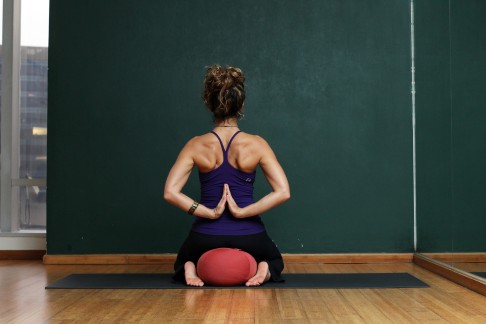
Seated hero pose
Kneel, resting your bottom on a yoga block or bolster. Press the top of each foot into the floor. This opens up and balances the hips, and stretches the ankles, knees and thighs. Put your palms together, as high up your back as possible. Draw your shoulders back and heart forward. This opens up the chest.
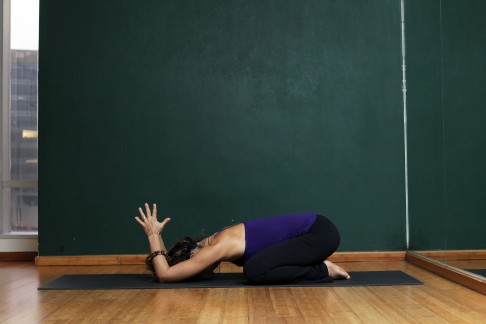
Child's pose
Kneel, sitting on your heels with your big toes touching and knees about a hip width apart. Stretch forward, lengthening the torso. With your elbows touching the floor, bring your palms together over your head. This opens up the shoulders, releases the spine and stretches the hips.
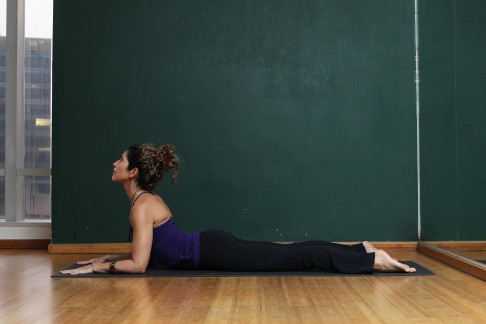
Sphinx pose
Lie on your belly, legs side by side. Place your elbows under your shoulders and forearms on the floor parallel to each other. Lift your torso and head into a gentle back bend. This releases the spine and is good for the kidneys. For an added challenge, straighten your arms. Note: Avoid this pose if you have diastasis or if you've very recently had a baby.
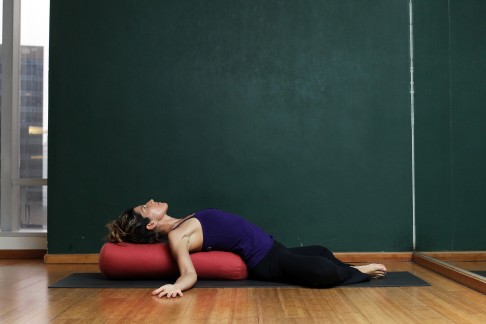
Reclining bound angle pose
Sit in front of a bolster with your feet together and knees pointing outwards, thighs open and touching the floor. Lean back and lie on the bolster, with your arms relaxed and out to your side, palms facing up. This opens the heart and releases tension in the shoulder and neck.
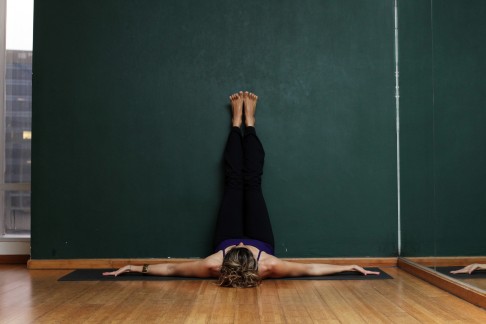
Legs up the wall
Lie with your legs up against the wall and arms out to your side. This posture calms the nervous system, eases muscle fatigue and helps restore healthy, restful breathing. It's good to ward off exhaustion, illness and weakened immunity. It helps you drop into a deeper state of relaxation and is a great way to end any yoga practice or day.
Tips for new mothers to avoid injuries
Learning proper movement patterns for typical activities with your baby can help new mothers avoid injuries. Here are some tips from the IDEA Fitness Journal, the monthly magazine of the IDEA Health & Fitness Association, an international organisation of fitness and wellness professionals.
Carrying the baby
• Keep the spine in neutral alignment, with the shoulders pulled back.
• Bring the baby to the body's centre whenever possible.
• Maintain a neutral wrist position, especially if experiencing carpal tunnel issues.
Feeding the baby
• Sit in neutral spine position in an ergonomically correct chair and use a foot rest.
• For a better feeding posture, use a support pillow to raise the baby.
• Set up a nursing station where everything is handy, to avoid reaching and twisting.
Pushing the stroller
• Keep the head and chin up, with ears over shoulders.
• Keep the shoulders depressed and retracted slightly, with chest leading.
• Hold the arms in a softly bent position, not locked.
• Try to keep the wrists in a neutral position. Carpal tunnel is prevalent in new mothers.
• Engage the abdominals throughout the movement.
• Take full, comfortable strides.